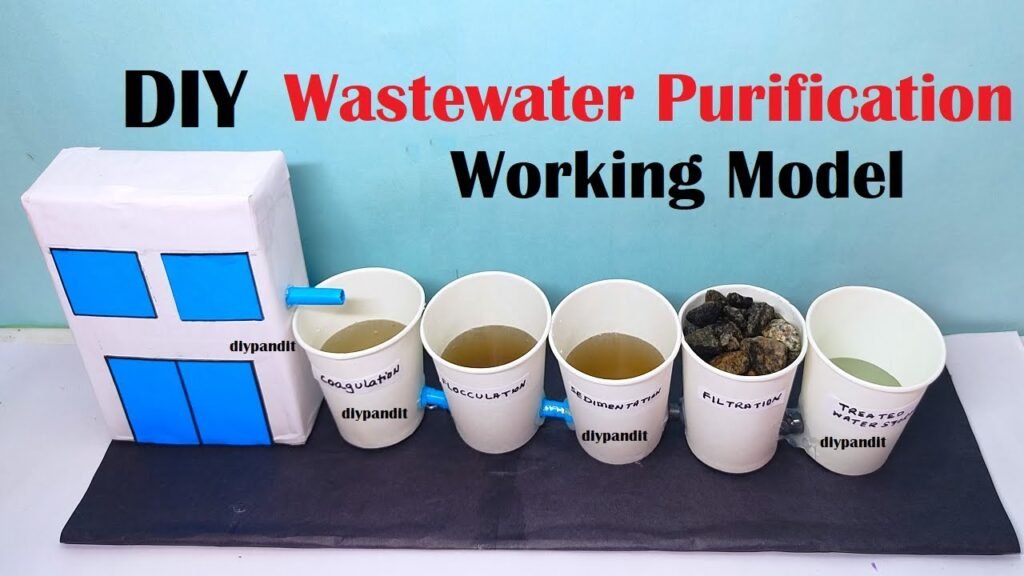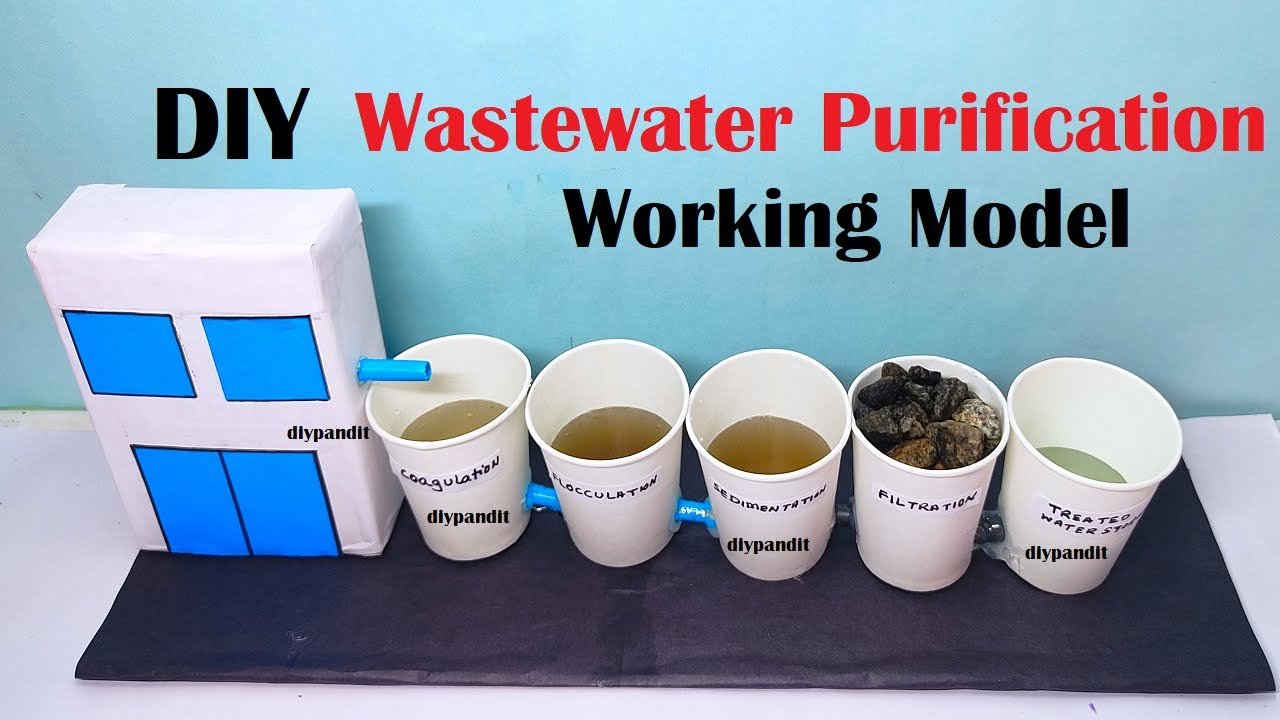Wastewater treatment is a process that involves removing pollutants and contaminants from wastewater to make it safe for disposal or reuse.
It aims to protect human health and the environment by treating wastewater before it is released into natural water bodies or returned to the water cycle.
Here’s how wastewater treatment works:
1. Preliminary Treatment: Wastewater enters the treatment facility through sewer systems. In the preliminary treatment stage, large debris, such as sticks, rocks, and plastics, are removed using screens and grit chambers. This prevents damage to equipment in later stages.
2. Primary Treatment: During primary treatment, large suspended solids in the wastewater are settled out. The wastewater flows into sedimentation tanks, where the velocity of the flow is reduced. Heavier particles settle to the bottom as sludge, while oils and grease rise to the top and are skimmed off. The partially treated water, called effluent, flows out of the tanks.
3. Secondary Treatment (Biological Treatment): Secondary treatment focuses on removing dissolved and suspended organic matter using microorganisms. The wastewater undergoes aeration, where air is bubbled through it to promote the growth of aerobic bacteria. These bacteria consume the organic matter, converting it into biomass and carbon dioxide. This process reduces the Biological Oxygen Demand (BOD) of the water.
4. Tertiary Treatment (Advanced Treatment): Tertiary treatment is employed to further refine the quality of the treated water. Processes such as filtration, chemical coagulation, and disinfection are used to remove remaining particles, pathogens, and residual pollutants. Chlorine, ultraviolet (UV) light, or ozone can be used to disinfect the water and destroy harmful microorganisms.
5. Sludge Treatment and Disposal: The sludge generated during primary and secondary treatment contains a mix of organic and inorganic materials. It is further treated to reduce its volume and stabilize its content. This can involve processes like anaerobic digestion, where bacteria break down organic matter in an oxygen-free environment. The treated sludge can then be used as fertilizer or disposed of in landfills.
6. Reuse and Resource Recovery: In some cases, the treated wastewater can be used for non-potable purposes like irrigation, industrial processes, or even toilet flushing. Additionally, some treatment plants incorporate resource recovery techniques to extract valuable components from wastewater, such as energy or nutrients like phosphorus and nitrogen.
7. Discharge or Reuse: After undergoing the various treatment processes, the water can be safely discharged into natural water bodies or reused for various purposes, depending on the quality standards and regulations set by environmental agencies.
The effectiveness of wastewater treatment is vital for maintaining environmental sustainability and public health. It ensures that the water released back into the environment is free from harmful pollutants, minimizing the impact on ecosystems and human communities.
Waste Water Purification Working Model Making
Creating a wastewater treatment or purification working model using cardboard, paper cups for different stages of filtration, and pipes to move through the filtration stages is an excellent way to learn about the process of treating and purifying wastewater.

Here’s a step-by-step guide on how to build this model:
Materials You’ll Need:
- Cardboard sheets (for the base and structure)
- Paper cups (for filtration stages)
- Small plastic or cardboard pipes or straws (for transferring water)
- Cotton balls (for one filtration stage)
- Gravel (for another filtration stage)
- Sand (for another filtration stage)
- Craft knife or scissors
- Hot glue gun and glue sticks
- Craft supplies for decoration (markers, stickers, etc.)
- Small container (for wastewater collection)
step by step wastewater treatment or purification working model
- Prepare the Base and Structure:
- Cut a piece of cardboard to create the base of your model.
- Cut and assemble cardboard pieces to create a simple structure that will hold the filtration stages.
- Filtration Stages:
- Use paper cups to represent the different filtration stages.
- Place the paper cups in a row on the structure, with enough space between them.
- Cotton Filtration:
- Fill one paper cup with cotton balls to simulate the first stage of filtration.
- This represents the initial removal of larger particles from the wastewater.
- Gravel Filtration:
- Fill another paper cup with gravel to simulate the second stage of filtration.
- The gravel will further remove larger particles and debris from the water.
- Sand Filtration:
- Fill another paper cup with sand to simulate the third stage of filtration.
- Sand helps in finer particle removal and purification.
- Pipe Connections:
- Attach small plastic or cardboard pipes or straws to connect the paper cups in sequence.
- This simulates the movement of water from one filtration stage to the next.
- Wastewater Collection:
- Place a small container at the end of the last filtration stage to collect the treated water.
- Water Flow:
- Pour the wastewater into the first paper cup.
- Observe how the water flows through each stage, with increasing levels of filtration and purification.
- Final Touches:
- Decorate the model with labels, signs, and other details to make it visually informative.
This model will help you understand the step-by-step process of wastewater treatment or purification through different filtration stages. It’s an engaging and educational way to learn about water treatment methods and the importance of clean water resources.
wastewater treatment questions asked in science exhibition with answers
Question 1: What is wastewater, and why is its treatment important?
Answer: Wastewater is used water from various sources like households, industries, and agriculture. Its treatment is crucial to remove pollutants and contaminants before it’s released back into the environment to protect public health and aquatic ecosystems.
Question 2: How does wastewater treatment help in preserving the environment?
Answer: Wastewater treatment removes harmful substances and pollutants from wastewater, preventing their release into rivers, lakes, and oceans. This safeguards aquatic life, reduces water pollution, and maintains ecological balance.
Question 3: What are the main stages of wastewater treatment?
Answer: The main stages of wastewater treatment include preliminary treatment (removing large debris), primary treatment (settling out solids), secondary treatment (biological treatment), and tertiary treatment (advanced filtration and disinfection).
Question 4: What role do microorganisms play in wastewater treatment?
Answer: Microorganisms, especially bacteria, are essential in the secondary treatment stage. They consume organic matter in the wastewater, breaking it down into harmless byproducts like carbon dioxide and water.
Question 5: How is sludge treated in the wastewater treatment process?
Answer: Sludge generated during treatment is treated further to reduce its volume and stabilize its content. Techniques like anaerobic digestion break down organic matter, and the resulting sludge can be used as fertilizer or disposed of properly.
Question 6: What is the purpose of disinfection in wastewater treatment?
Answer: Disinfection eliminates harmful bacteria, viruses, and pathogens present in the treated wastewater. It ensures that the water is safe for the environment and any potential reuse.
Question 7: Can you explain the concept of resource recovery in wastewater treatment?
Answer: Resource recovery involves extracting valuable components from wastewater, such as energy or nutrients. For example, methane gas produced during sludge digestion can be used as an energy source, and nutrients can be reused as fertilizers.

